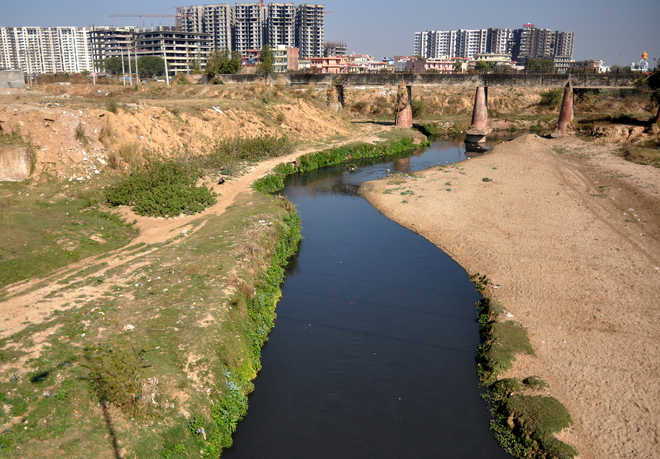Amarjot Kaur
Tribune News Service
Chandigarh, January 29
Maintained by both, the Chandigarh Municipal Corporation and the UT Administration, city’s natural choe (N-choe), which also flows through Mohali, is afflicted by pollutants and untreated sewerage water. Raising a pungent stink at Sector 66-A bridge leading to the Airport road, it has become a nagging issue for those living in residential colonies not far than a couple of kilometres from the seemingly dark blue serpentine stream.
Lieutenant Commander of the Indian Navy ML Sharma (retd), who resides in Falcon View, voices his grouse angrily. He said: “I had been knocking at the doors of the authorities concerned, but they lack the will to work on this issue. This rivulet stinks, day in and day out, making it difficult for us to live here. The water of this stream brings along the dirt of the City Beautiful and all its sewerage waste.”
An official from the Punjab Pollution Control Board divulges the details of the choe, backing Sharma’s claims. “When it flows to Mohali, the choe does get polluted water from Chandigarh. It raisers a foul smell in Sector 23, from where its quality starts deteriorating,” he shared on condition of anonymity.
Trailing N-choe
As this correspondent sets off to track the course of N-choe, a waterless land under the bridge near the Secretariat announces no apparent pollution hazard. Running along the well-manicured lawns of the Leisure Valley, Sector 10, the choe fills up with a small stream of water but only in parts. It looks dirty and littered with plastic waste near Rose Garden, but invites a mild stink at the Children Traffic Park, Sector 23, which amplifies as one reaches Fragrance Garden in Sector 36.
In fact, the water of the choe on the bridge near Alliance Françoise, right behind MCM DAV College for Women, Sector 36, is polluted by solid plastic waste and with muck accumulated on its surface it appears to have stagnated in a depression, allowing very little water to flow down south. However, as it reaches Sector 42, flowing behind the new lake, the choe stinks and is littered with plastic. It continues to get worse with each passing sector till it reaches the Airport road and then to Jagatpura, before it finally joins the Ghaggar in Haryana.
Who’s to blame
As per the last year’s water analysis report of the Pollution Control Board, Patiala, samples collected from sewerage treatment plants of the N-choe near the bridges of Dicri village, Sector 67 and Phase 9 in Mohali do not comply with the norms of the Pollution Control Board. The highest bio-chemical oxygen demand (BOD) was recorded in Dicri at 16, while the highest chemical oxygen demand was 83 in the same village. Topping the charts at 81, Phase 9 scored 81 on total suspended solids, while Dicri bagged 417 on total dissolved solids (which is 67 points higher than the permissible 350).
Harish Saini, executive engineer, MC, said: “Earlier, we could discharge treated sewerage water in N-choe or other water bodies if the BOD was less than 30. Now, as per the revised norms, a year and a half ago, it has to be less than 10. We are upgrading our sewerage treatment plants so that affluent impurity level is less than 5, under the Smart City project. An executive committee, constituted by the NGT, conducts a survey every month and we have identified more points of sewage water discharge. The report has been submitted to the NGT and the Pollution Control Board. Sometimes people make illegal connections in the storm line and it is difficult to locate them. Till Sector 20, we have tapped all such points. Also, we have diverted the water in Sector 23.”
UT Administration’s Chief Engineer Mukesh Anand said the department was looking after the cleanliness of the choe. “I am only responsible for cleaning the choe. As far as sewerage stink is concerned, it is MC’s responsibility. We have got it cleaned two months ago, but it gets polluted. So it’s a periodical process. We’ll get it cleaned again,” he assured.
Unlock Exclusive Insights with The Tribune Premium
Take your experience further with Premium access.
Thought-provoking Opinions, Expert Analysis, In-depth Insights and other Member Only Benefits
Already a Member? Sign In Now











